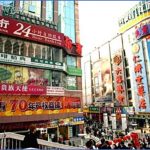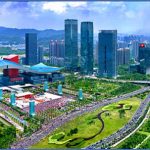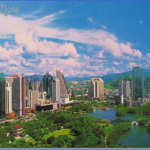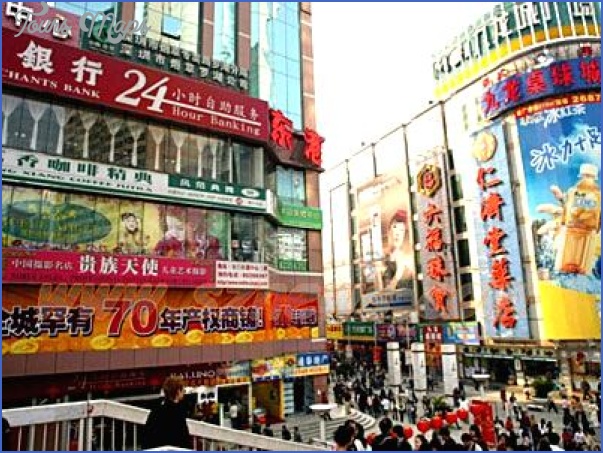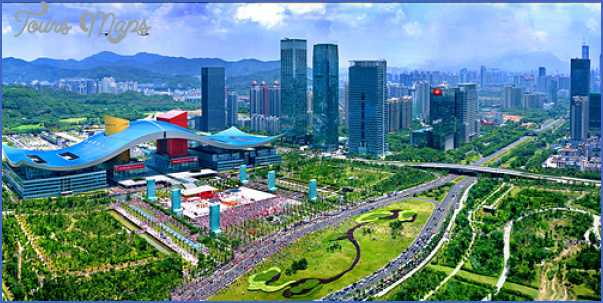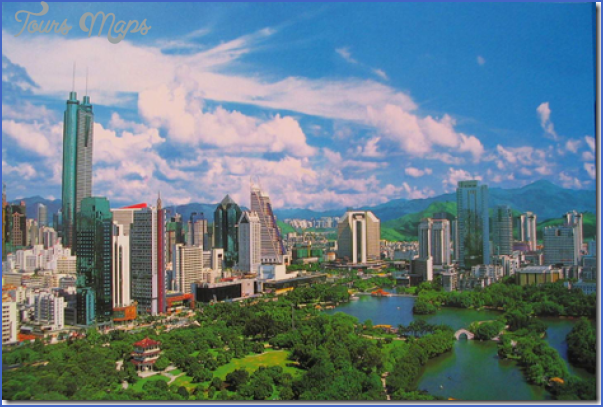LANGUAGE
Shenzhen is an almost purely Mandarin speaking city. It is an immigrant city whose people come from all over China and who use Mandarin as their daily language. It is an island of Mandarin in a sea of Cantonese. One hundred yards to the south of the Hong Kong Shenzhen border, the majority of individuals born there speak Cantonese and English at home, while most youngsters learn and understand Mandarin at school. To the north in Dongguan City and especially in Guangzhou, the majority of those born there are Contonese speakers at home, while, most can understand and speak some Mandarin.
You hear Cantonese only occasionally although there are remnant islands of Cantonese in the City, especially around the urban villages near the Huanggang border crossing. The Shenzhen Metro, which is operated by the Hong Kong MTR, gives announcements in Cantonese as well as in Mandarin and English. In everyday life it seems that the second dialect, certainly the dialect of most taxi drivers, is Hunanese. Other dialects you may hear via taxi intercoms include Hakka, Fuzhou, Maoming, Chaozhou and Hubei.
Cantonese has one anomaly in Shenzhen. South of Fuhua Rd, several villages, including a couple in Hong Kong, spoke a very aberrant variety of Cantonese called Weitou Dialect, the dialect of the wei or fortified villages. A quick look at the dominant surnames in these villages suggests that the villagers are descendents of the people who were chased south by Mongol forces in the thirteenth century.
Shenzhen in 2014 is China’s fifth biggest city, its richest city and, in the minds of some, China’s first First World city. It has a reputation as the centre of world manufacturing and to some extent this is true. But the rising price of land and labour in Shenzhen is gradually forcing factories out of the city. For example most of the world’s watches were once made in Shenzhen but now all watch making has moved inland.
Manufacturing is rapidly being replaced by services. Shenzhen has one of Mainland China’s two stock exchanges. Two of China’s six listed banks, China Merchants Bank and Shenzhen Development Bank are based in the city. China’s largest financial institution, Ping An, has its headquarters in Shenzhen as does China’s largest property developer, Vanke. Forty percent of China’s mutual funds are managed from Shenzhen. Until its acquisition by Air China, Shenzhen Airlines was China’s largest privately owned airline. Electronics companies such as Hua Wei and ZTE, which are now amongst the world’s top five, have their headquarters and R & D in Shenzhen. Add to this the offices of all the major insurance companies, what will soon be the world’s biggest container port and China’s fourth busiest airport and the services story becomes compelling.
Shenzhen is a busy transport hub, being the only Chinese city with sea, air and land ports. The Huanggang border checkpoint is the biggest land freight entry point in China and major expressways link Shenzhen with all major Chinese cities.
DAILY LIFE
The preponderance of office workers resulting from this leaves the observer with an overwhelming sense of bourgeois normalcy. Suit-clad men and women stroll to work along tree-lined avenues onto underground trains or buses to be disgorged at large complexes of offices. Crowds of office workers gather for loud animated lunches. Dog lovers congregate in parks at dusk and compare over-groomed dogs. There are now over nearly three million cars registered in Shenzhen and this number is growing rapidly. Somtimes this has terrifying consequences as ever more inexperienced drivers crowd the roads.
Shenzhen above all is an immigrant city. Nobody comes from Shenzhen. In thirty years the city population has grown from nearly nothing to more than 14 million, almost all by immigration. Everybody goes home to somewhere else for Chinese New Year. Everybody speaks Chinese with some kind of strange accent.
Shenzhen is a young city. Twenty five to thirty five years of age is by far the largest statistical cohort. It is well educated, some say the best educated city in China. A degree is a common possession. It has crowds of children, way more than you would expect from a city that practises a one-child policy. Nobody has really explained this anomaly to us but the large numbers of children we see on the streets suggests to us that there are more important policies to be pursued by the City Government than the one child policy. Old people are rare. It is a sign of success as well as of filial piety to bring your aged parents down from the provinces to live in your large apartment. Living together without marriage is more common than in many places in China. Conversely many friends complain to us of the difficulty of finding a mate for marriage. It seems that parental introduction still plays a critical part in marriage.
At the other end of the social scale are the migrant workers who make up the factory workforce. They are relentlessly optimistic and live in hope of earning the sort of money that their parents and grandparents back in the village could only dream of. Many of them, particularly the young, live in bare surroundings in sushe or dormitories; they work long hours, save, and dream of their triumphal return to their home villages. As Chinese New Year approaches, they gather their savings, get their hair done bad luck to wash it after New Year! and buy new clothes. They crowd the buses and planes in incredible numbers and return to their hometowns as conquering heroes, urban sophisticates with tales of city life and armfuls of gifts. Meanwhile the city, which they have left, lies silent, empty of people, until they all return and start a new year.
CULTURE
As well as being a moneyed city, Shenzhen is a city of culture. This is not surprising when one considers the historical relationship between economic success and high culture. Without the eastern Mediterranean trade, Venice and Florence would never have become great centres of culture. Shenzhen loves books. It has a giant library and the world’s largest bookshop. Art Galleries have proliferated throughout the city, ranging from the exuberance and vulgarity of the artist’s settlement at Da Fen through the political statements of the He Xiangning Gallery to the absolute avant-garde at Overseas Chinese Town’s galleries. It boasts major concert halls and is on the visit schedule of some of the world’s leading musicians. Meanwhile every child of a bourgeois family is kept back practising instruments which his parents only dreamt of and which his grandparents had never heard of. Shenzhen’s architecture is famous in China and abroad. The city centre at Futian has buildings in every imaginable style. The architecture school at Shenzhen University has an enviable reputation and local architects have raised the levels of their efficiency to such an extent that a multi-storey building takes two weeks design time from start to finish. No time for adjusting the bow-tie here.
Shenzhen is a city of gardens. After Dongguan it has China’s highest ratio of gardens to population. This is officially recognised by the International Association of Gardens and Recreation Facilities that in 2000 awarded it the title of International Garden City.
Traveling in Shenzhen Photo Gallery
Maybe You Like Them Too
- The Best Cities To Visit in The World
- World’s 10 Best Places To Visit
- Coolest Countries in the World to Visit
- Travel to Santorini, Greece
- Map of Barbados – Holiday in Barbados

